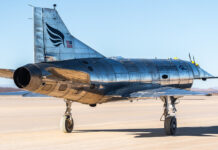“We find ourselves facing a real and increasing need to address a broad range on non-conventional threats including terrorism, piracy, low intensity conflicts, natural disasters and pandemics.” said Teo Chee Hean, Singapore’s Minister for Defence addressing the air chiefs from 41 nations assembling for the 4th Global Air Power Conference held in Singapore, Fen 18, 2008. Mr. Teo Chee Hean referred to the widening spectrum of security challenges and the possible ways to address them. “These threats are not confined within borders and can spread rapidly. They can affect the security on not just a single country or region but could influence the entire international community – no single country can address these threats on its own” said the minister, referring to the need for more international and regional cooperation and collaboration.
“The inherent characteristics of air power – flexibility and mobility – make it well suited to meet today’s challenges” the minister said. “The peace and prosperity that Singapore, as a small nation, enjoys is very much underpinned by a peaceful and secure region and world.” He referred to the Five Power Defence Arrangements (FPDA) where Singapore has been an active member since 1971, collaborating with Malaysia, Australia, New Zealand and the United Kingdom. Two exercises are conducted annually under the FPDA agreement, an air defense and air operations exercise. Furthermore, the ongoing ‘Eye in the Sky’ maritime security program, jointly undertaken by Malaysia, Indonesia and Singapore significantly improved security across the Malacca straits, a strategic maritime route carrying one third of the world’s sea trade and 50% of the world’s oil. “Since the inception of ‘Eye in the Sky’ in 2005 the incidence of sea robberies in the Malacca Straits has declined sharply” said Teo Chee hean. This contributed to the removal of the Malacca Straits from Lloyd’s list of war-risk areas in 2006.
Maj. General Ng. Chee Khern, Chief of RSAF addressed the regional and international cooperation as one of the cornerstones of Republic of Singapore Air Force (RSAF) activities. “Sharing doctrine, concept of operation, software and even source code are vital elements of such cooperation” he said. According to General Khern, cooperation, in addition to air security, precision strike and information dominance are essential capabilities of the modern air power.
Air Marshal Subandrio, Chief of Staff Indonesian Air Force reinforced the point of regional security and defense cooperation in the region. Air Marshal Subandrio also emphasized the role of the air force as one facet of a three-tier national airpower strategy, which also extends to commercial air capability as well as aerospace industry. He underlined the key role of the air force supporting maritime surveillance, and environmental monitoring, such as fire protection of the rain forest. The Chief of Indian Air Force, Air Chief Marshal Fali Homi Major, Chief of Staff Indian Air Force also underlined the role of cooperation as part of regional and national security. He also addressed the broader scope of airpower in international politics, “There is a tendency to relate airpower with military power” said Chief Marshal Fali Homi Major, yet, “due to its universal applicability, small footprint and strategic effect, airpower has evolved to become the preferred instrument for power projection, to protect, deter, punish and assist the peace”.
To sustain these capabilities the IAF is modernizing its forces with the acquisition of new systems, modernization of existing platforms and sustainment and preservation of aging assets. Among the new acquisitions he mentioned the upcoming selection of new multi-role combat aircraft, fielding of Airborne Warning & Control aircraft, acquisition of new helicopters and two multinational development programs launched with Russia – the development of 5th generation fighter and medium range airlifter. He also said that India intends to leverage domestic commercial air capability to support the Air Force, as part of its thrust to improve indigenous technological and technical infrastructure. This thrust is also being improved by the mandatory technology transfer, and offset requirements set by the government, resulting in the establishment of new joint ventures between domestic and international industries.
A different view was presented by Air Marshal Geoffrey D. Shepherd AO, Chief of the Royal Australian Air Force (RAAF). “The security situation in Asia Pacific is becoming more complex with threats ranging from illegal immigration, piracy and drug trafficking to international terrorism; the situation in the region has become the worst since the end of World War II” He said. According to Air marshal Geoffrey, the RAAF should transform itself from a tactical air force on a more ambitious “Strategic Air Force”, addressing threats and challenges on a regional and global scale. RAAF is preparing for such strategic missions by fielding new platforms, such as the C-17 Globemaster, new Multi-Role Transport Tankers (MRTT), Wedgetail Early Warning Aircraft and is planning to replace its fleet of P-3 Orion Maritime patrol aircraft. “If you don’t shape your environment it is being shaped for you (by international terrorism)” said RAAF Chief of Staff.
The following articles are included in this review:
- Unmanned Aerial vehicles at the Singapore Airshow
- Singapore Establishes a Networked Air Defense Capability
- Asia-Pacific Air Powers Address Asymmetric Threats & Cooperation
- Afghan Missions Are Shaping NATO’s Priorities
- Airpower Fighting Terror – the Israeli Style



















